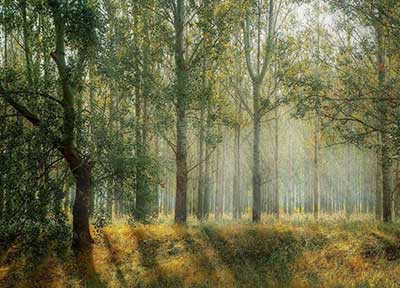Relevance: GS-3: Conservation, environmental pollution and degradation, environmental impact assessment. Disaster and disaster management.
Key Phrases: Biophysical and Biochemical Effects, Global Warming, Conservation Efforts, Frontiers in Forests and Global Change, Water and Energy Balance, Albedo, Evapotranspiration, Canopy roughness, volatile organic compounds, Surface temperatures, UN climate report.
Why in News?
- Considering both biophysical and biochemical effects of forests in tandem can give a more wholesome picture of the potential of forests in offsetting global warming and boost conservation efforts.
Context:
- Usually, when scientists and policymakers consider the amount of carbon that a forest can extract (‘sequester’) from the atmosphere, they just consider the amount of carbon stored in the biomass (put simply, the trees). However, a recent study sheds light on a parallel phenomenon that is equally important in sequestering carbon from the atmosphere.
- Writing in Frontiers in Forests and Global Change, Lawrence et
al. (2022) report on the impact forest-cover change has on abiotic
processes like water and energy balance. These biophysical processes
have a considerable – but hitherto under-examined – impact on the carbon
sequestration potential of the ecosystem. These biophysical effects are:
- Albedo, ie, the amount of incoming radiation reflected by the ground
- Evapotranspiration (ET) or the evaporation of water from land and the evaporation of water vapour from plant stomata
- Canopy roughness – essentially a metric to measure the irregularities of the canopy surface. A high canopy roughness encourages vertical mixing and draws heat and water vapour from the surface.
- The tropics inevitably receive more sunlight and moisture, which gives more energy to drive ET and cool the air near the surface. At higher latitudes, albedo is the most prominent biophysical driver as vegetation is patchy and sunlight seasonal. Another physico-chemical phenomenon is the release of volatile organic compounds (VOCs) by forests. Their reaction with atmospheric oxygen produces secondary organic aerosols that are not only highly reflective (this causes cooling) but also concentrate clouds (aka ‘cloud condensation nuclei’) that increases ‘cloud’ albedo.
- The authors examined effects of forest cover change on carbon stocks wrought out by abiotic factors, and then segregated these according to latitudes. To this end, they compiled quantitative data on biophysical factors from published literature. The data consists of both ground-based examinations as well as remote sensing. Here, both techniques usually use an area covered with forests and bereft of one as a proxy for afforestation and deforestation respectively. This was done at three scales – local, regional, and global – and for tropical rainforests in three continents: Latin America, Central Africa and South-East Asia.
- Surface temperatures in areas under forest cover are ‘significantly lower’ than in areas bereft of cover, according to the study. In tropical forests, an average local surface cooling of 0.96-degree C was observed, while in temperate forests, the average cooling was 0.4-degree C. In boreal (Arctic) forests, it was 1-degree C.
Biophysical Cooling Effects
- Results revealed that biophysical cooling effects brought about by biophysical/abiotic drivers change by latitude in a rather predictable manner. From the equator to 30-40 degree N, biophysical effects augment CO₂ sequestration in cooling the global environment. In the mid-latitudes up to 50 degree N, deforestation leads to a ‘modest’ net global warming. Beyond 50 degree N deforestation leads to an increased cooling.
- In the event of deforestation, albedo changes induce cooling, though this is offset by warming effect of lost canopy roughness. In tropics, once the warming from lost evapotranspiration is accounted for, the net biophysical effect from tropical deforestation is global warming.
- At higher latitudes (i.e. 20-30 degree N), albedo compensates for the combined effect of canopy roughness, evapotranspiration, VOCs, ‘resulting in close to zero net biophysical effect on global temperature.’ At even higher latitudes (30-40 degree N), albedo is the most powerful biophysical driver and so, deforestation in these latitudes leads to net cooling.
- These biophysical effects of forests add a moderating influence to the local and regional climate, which explains why, after deforestation, hot days become increasingly common even in mid- and high-latitudes. ‘Historical deforestation explains nearly one-third of the present day increase in the intensity of the hottest days of the year at a given location,’ the article states.
- In a press release, Deborah Lawrence, lead author of the study, issues a foreboding warning: ‘A recent major UN climate report showed we must urgently act now to avoid the worst case scenarios for our planet… If we lose these forests, we will get there 10 years faster. If we protect these forests, they will shield us from extreme climate disasters, droughts and impacts on our food and agriculture. We are benefiting now from the tropics keeping us cooler; they are keeping us from feeling these extremes already,’ she said.
Food and Agriculture Organisation Finding
- According to Food and Agriculture Organisation (FAO), tropical forests, which have one of the fastest carbon sequestration rates per unit land area, face the greatest deforestation pressure. Tropical forests store nearly a quarter of terrestrial carbon on the planet and can also cool the earth by as much as 1-degree C, and even more if we factor in biophysical effects. The study further adds that restoring forests in the 0-10 degree N region would deliver 25 per cent more global cooling than expected based on CO2 sequestration alone.
Way Forward:
- Considering both biophysical and biochemical effects of forests in tandem can give us a more wholesome picture of the potential of forests in offsetting warming and, thereby, help governments in devising better conservation and climate strategies.
Source: Indian Express
Mains Question:
Q. “Biophysical and Biochemical Effects of forests in tandem can give a more wholesome picture of the potential of forests in offsetting global warming and boost conservation efforts”. Critically analyse.









